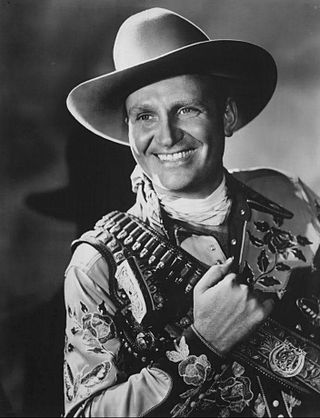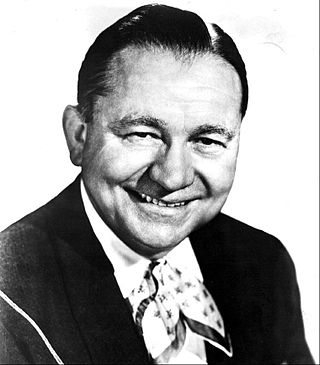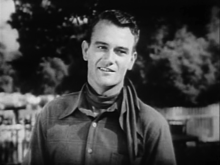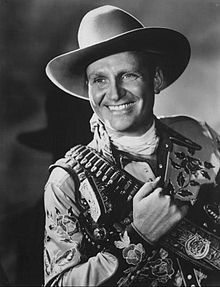
Orvon Grover "Gene" Autry, nicknamed the Singing Cowboy, was an American actor, musician, singer, composer, rodeo performer, and baseball team owner, who largely gained fame by singing in a crooning style on radio, in films, and on television for more than three decades, beginning in the early 1930s. During that time, he personified the straight-shooting hero — honest, brave, and true.

Roy Rogers, nicknamed the King of the Cowboys, was an American singer, actor, television host, and rodeo performer.

Woodward Maurice "Tex" Ritter was a pioneer of American Country music, a popular singer and actor from the mid-1930s into the 1960s, and the patriarch of the Ritter acting family. He is a member of the Country Music Hall of Fame.

Bob Nolan was a Canadian-born American singer, songwriter, and actor. He was a founding member of the Sons of the Pioneers, and composer of numerous Country music and Western music songs, including the standards "Cool Water" and "Tumbling Tumbleweeds." He is generally regarded as one of the finest Western songwriters of all time. As an actor and singer he appeared in scores of Western films.

Kenneth Olin Maynard was an American actor and producer. He was mostly active from the 1920s to the 1940s and considered one of the biggest Western stars in Hollywood.

Lester Alvin Burnett, better known as Smiley Burnette, was an American country music performer and a comedic actor in Western films and on radio and TV, playing sidekick to Gene Autry, Roy Rogers, and other B-movie cowboys. He was also a prolific singer-songwriter who is reported to have played proficiently over 100 musical instruments, sometimes more than one simultaneously. His career, beginning in 1934, spanned four decades, including a regular role on CBS-TV's Petticoat Junction in the 1960s.

Television Westerns are programs with settings in the later half of the 19th century in the American Old West, Western Canada and Mexico during the period from about 1860 to the end of the so-called "Indian Wars". More recent entries in the Western genre have used the neo-Western subgenre, placing events in the modern day, or the space Western subgenre but still draw inspiration from the outlaw attitudes prevalent in traditional Western productions.

John Nicholas "Dick" Foran was an American actor and singer, known for his performances in Western musicals and for playing supporting roles in dramatic pictures. He appeared in dozens of movies of every type during his lengthy career, often with top stars leading the cast.
Monte Hale was an American B-Western film star and country musician.

Geremino Bisceglia, better known as Tex Fletcher, was an American singing cowboy with credits as a recording artist, Broadway and movie actor, night club performer, and radio and television personality.

Douglas Bruce Green, better known by his stage name Ranger Doug, is an American musician, arranger, award-winning Western music songwriter, and Grand Ole Opry member best known for his work with Western music and the group Riders in the Sky in which he plays guitar and sings lead and baritone vocals. He is also an exceptionally accomplished yodeler. With the Riders, he is billed as "Ranger Doug — The Idol of American Youth" and "Governor of the Great State of Rhythm". He is also a member of The Time Jumpers.

Jasper Joseph Inman Kane was an American film director, film producer, film editor and screenwriter. He is best known for his extensive directorship and focus on Western films.

Riders of Destiny is a 1933 pre-Code Western musical film starring 26-year-old John Wayne as Singin' Sandy Saunders, the screen's second singing cowboy. It was the first of a series of sixteen Lone Star Westerns made for Monogram Pictures between 1933 and 1935, by Wayne and director Robert N. Bradbury, and the first pairing of Wayne with George "Gabby" Hayes.

In Old Santa Fe is a 1934 American Western film directed by David Howard, starring Ken Maynard, George "Gabby" Hayes and Evalyn Knapp and featuring the first screen appearance of Gene Autry, singing a bluegrass rendition of "Wyoming Waltz" accompanied by his own acoustic guitar with Smiley Burnette on accordion. Autry and Burnette were uncredited, but the scene served as a screen test for the duo for subsequent singing cowboy films, beginning with The Phantom Empire (1935), in which Autry had his first leading role.

James Clarence Wakely was an American actor, songwriter, country music vocalist, and one of the last singing cowboys. During the 1930s, 1940s and 1950s, he released records, appeared in several B-Western movies with most of the major studios, appeared on radio and television and even had his own series of comic books. His duet singles with Margaret Whiting from 1949 until 1951, produced a string of top seven hits, including 1949's number one hit on the US country chart and pop music chart, "Slippin' Around". Wakely owned two music publishing companies in later years, and performed at the Grand Ole Opry until shortly before his death.

The Old Corral is a 1936 American Western film directed by Joseph Kane and starring Gene Autry, Smiley Burnette, and Irene Manning. Based on a story by Bernard McConville, the film is about a sheriff of a small western town who sings his way into a relationship with a singer from a Chicago nightclub who earlier witnessed a murder. The supporting cast features Lon Chaney Jr. and Roy Rogers.

Home in Wyomin' is a 1942 American Western film directed by William Morgan and starring Gene Autry, Smiley Burnette, and Fay McKenzie. Based on a story by Stuart Palmer, the film is about a singing cowboy who helps out a former employer in trouble with his failing rodeo while romancing a woman reporter. In Home in Wyomin', Autry sang his hit songs "Be Honest with Me", "Back in the Saddle Again", and "Tweedle O'Twill", as well as Irving Berlin's "Any Bonds Today", becoming the first major star to sing the official song of the U.S. Defense Bond campaign during the war.
Fleming Allan was an American composer of Western music, who helped make that genre popular in the 1930s.

This Gene Autry filmography lists the films and television episodes starring the American singing cowboy Gene Autry.
Edward Francis Finney (1903–1983) was an American film producer and director. He is best known as the man who introduced cowboy singer Tex Ritter to the moviegoing public.

























